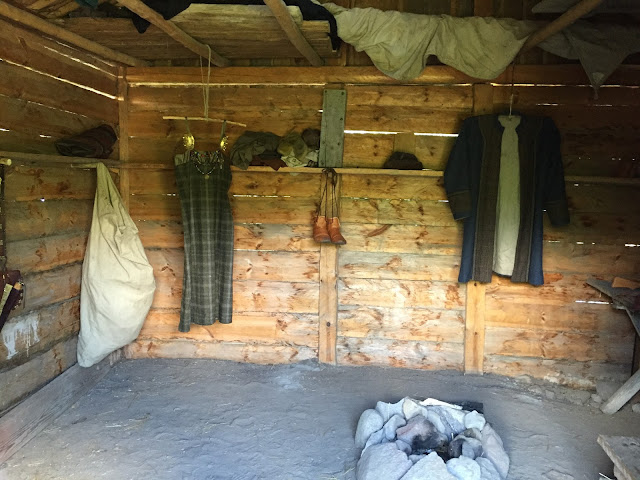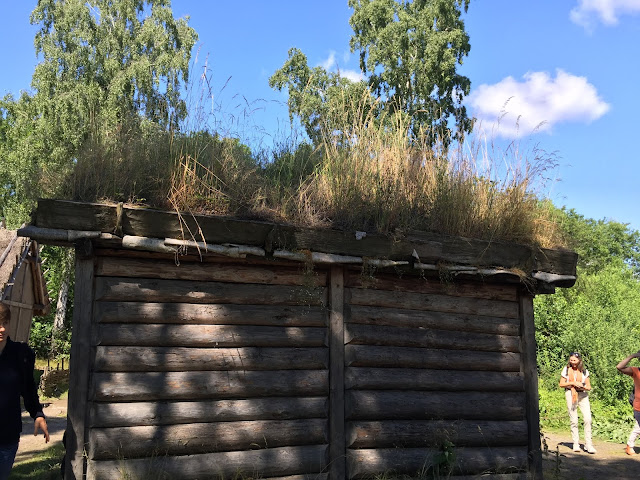Over the weekend, we took a trip to Birka. This Viking Age town is considered to be Sweden's first town, active from 750-960 A.D. Birka is located on the island of Björkö in Lake Mälaren; therefore, we had to take a boat to get there. The Stromma line organizes tours leaving from City Hall in Stockholm.
 |
| Our boat to Birka |
During the ride, a guide explained the sights we were passing in relation to the Viking Age. After a two hour boat ride, we arrived in Birka.
 |
| Belle enjoyed her breakfast on the boat |
 |
We arrived around lunchtime. Since we were all starving, we decided to stop by the cafe for sandwiches.
|
 |
| Exploring the grounds |
 |
| Our ticket included a guided tour and entrance into the museum. |
 |
| This is the only picture of Belle on the tour. After being on the tour for about 10 minutes, she wasn't happy anymore. Cyle took her back to the museum where she fell asleep while I continued with the tour. |
 |
Our tour guide
All the guides are archaeologists who have spent time excavating Birka. They are very knowledgeable and excited to share this knowledge with their tour groups. He was able to paint a good picture of what Birka was like during the Viking Age. |
 |
The grave mounds
It is estimated that there are around 3,000 graves in Birka. The size of the grave mound depended on your wealth- the wealthier you were, the bigger your grave mound as you had more stuff at your burial.
 |
 |
View from atop the grave mounds
In the background is the small city of Birka today. Only about ten people still live in Birka. It's so small that the children have to leave by boat every morning to go to school as there isn't a school on the island.
|
 |
| Across the field is where the town of Birka once stood. At it's height, Birka is estimated to have had a population of around 700 inhabitants. Unfortunately, none of the structures of the town remain as everything was constructed from wood. |
 |
| In the museum, a replica was built to help visitor's imagine what the town would have looked like. |
For 200 years, Birka was an important trading center for the vikings. During the Viking Age the water level was much higher and Birka was directly connected to the Baltic Sea. Archaeological excavations have revealed silver, coins ,pearls, and other items from mainland Europe as Arabic and Russian regions.
 |
View from the bottom of the hill fort
To protect the city, Birka had a massive hill fort. The earthen walls of the fort are still visible today, but during Viking times, a wooded palisade would have topped off the fort. Our guide informed us, however, that, unlike the older hillforts, this one had no buildings – the wall itself was all there was to the structure. The people only went to the fort during times of attack.
|

 |
| Standing at the top of the hill fort |
In 829, Ansgar, a Benedictine monk, came to Birka to try and Christianize the heathens. Scandanavia was one of the last places in Europe to be Christianized. It is said that he was well received and was even given a plot of land to construct a church. (The church is still yet to be found.) He was successful in Christinazing a handful of Vikings; however, after he left, many of the converts reverted back to their pagan religion.
 |
A monument to Ansgar constructed in 1834 to celebrate the 1,000 year anniversary of the arrival of Ansgar
 |
Birka, the Swedish Viking trading center, lasted only two centuries. Founded at the end of the eighth century, it was abandoned by the end of the 10th. While we aren't sure why Birka ended, there are several theories. Water levels in Lake Mälaren fell, making Birka’s harbors less appealing; trade patterns changed, and — perhaps most importantly — the town of Sigtuna was founded on the Swedish mainland around AD 970. Birka’s population either moved to Sigtuna or was ordered to move.
To help truly visualize what Birka would have looked like, there's a reconstruction museum of the Viking village. It is made up of 4 or 5 dwellings, gardens and boats. The Vikings go about their business doing their daily chores. There, visitors can immerse themselves in Viking life as it's like stepping back in time.

 |
| A family tends to their chores |
 |
| The iron smith has laid out his tools in front of a live fire. |
 |
| A look inside a viking home |

After visiting the town, I am very happy to be living in the modern age!
After several hours on the island, it was time to make the journey back to Stockholm.
 |
| Belle provided the entertainment ;) |
Many of the archaeological finds are housed at the Swedish History Museum, which we had visited with my parents in February.
 |
| It was common to bury animals with the deceased. One a person died, their animals would also be put to death so they could be buried with their owners. |
 |
| Replica of Viking Clothing |








































No comments:
Post a Comment